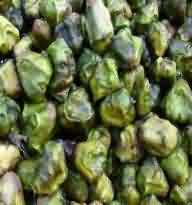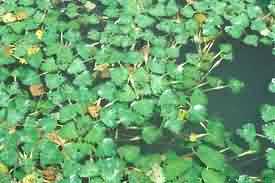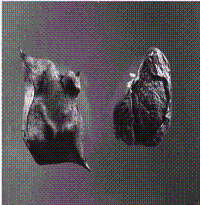सिंघाड़ा के उत्पादन प्रौद्योगिकी
 Water chestnut (Trapa natans) is one of the most important minor fruit crops grown in India. It is an aquatic nut crop grown mainly in the tropical and sub-tropical region, as submersed plant community. It also thrives in the soft nutrient rich waters in lakes, ponds and streams with a neutral to slightly alkaline pH. The plant is well adapted to life at the water’s edge and prospers even when stranded along muddy shores.
Water chestnut (Trapa natans) is one of the most important minor fruit crops grown in India. It is an aquatic nut crop grown mainly in the tropical and sub-tropical region, as submersed plant community. It also thrives in the soft nutrient rich waters in lakes, ponds and streams with a neutral to slightly alkaline pH. The plant is well adapted to life at the water’s edge and prospers even when stranded along muddy shores.
In India, it is most commonly used as edible nut. The kernel of water chestnut contains a large amount of protein (up to 20%), starch (52%), tannins (9.4%), fat (up to 1%), sugar (3%), minerals, etc. It is also a good source of fibre and vitamin B along with Ca, K, Fe and Zn.
Varieties of chestnut:
No standard variety of water chestnut is released till now. But nuts with different husk colour like green, red or purple and a blending of red and green colour are recognized. Kanpuri, Jaunpuri, Desi Large, Desi Small etc. are the names of some types of water chestnuts referred to the growers in West Bengal and other parts of eastern India.
Propagation of chestnut:
Propagation of the plant is commercially done by seeds. The fully mature nuts are placed in container with little water to germinate the seeds. The sprouted seeds are sorted out and broadcast in the nursery tanks. At the beginning of monsoon, the seedlings are lifted from the nursery tanks and planted in pond, at a spacing of 1-2 meters or 2-3 meters when the soil of the pond is fertile.
Climatic requirement to grow chestnut:
Water temperature of 12-150C is absolutely necessary for the fruit to germinate while 200C is required for development of the flower. The temperature range throughout the year is dependent on continental climatic conditions, i.e. high temperature during spring and summer and low in winter is beneficial for successful production of the crop.
Soil:
As it is an aquatic plant, soil does not play so much important role for its cultivation. But it is found that water chestnut gives better yield when the soil of the water bodies is rich, friable which is well manured or fertilized.
Nutrient management:
Water chest-nut requires some specific nutrient elements for better growth and development. Fertilizer with moderate amount of poultry manure is very essential for higher yield. But it needs little application of phosphorus and potassium. It can thrive well under a pH range of 6 to 7.5. Growers from different parts of the world uses dolomite (a form of lime that contains magnesium) to adjust pH is which one of the most important works during nutrient management practice.In West Bengal, application of 30-40 kg of urea in per ha area of pond after about a month of transplanting and again after another 20 days is highly recommended.
Transplanting:
It is recommended that plants are first grown in a low nutrient nursery plot and transferred when stems are about 300 mm tall. This reduces the growth period in ponds by up to 6 weeks. Tops may be trimmed if they are too tall at transplanting. Care should be taken at the time of transplanting so that seedlings kept moist but not submerged.
Hydroponics:
Water chestnuts may also be grown hydroponically, using buckets and a suitable medium such as permite plus vermiculite. The buckets can be kept topped up with old nutrient solution from other crops.
Water for chestnut crop:
The soil should be kept flooded with 100mm to 300mm of water throughout the growing period. A greater depth of water is tolerated by the plants but they do not prosper Water should drained off prior to harvesting. When filling containers with soil it should be ensure to allow for 100mm of water.
Situations & Containers:
They can be grown in any medium to large container that holds water like old bathtubs, kid’s wading pools or styrofoam broccoli boxes. Alternatively, you can grow them in a plastic lined trench in the vegetable garden. On a larger scale they are grown in flooded fields like rice. These fields are ideally located below a water source like a dam so that the water level can be maintained with a gravity flow. They can also be grown on dam and pond edges but only if the water level is controllable and stable.
Intercultural operations:
Reduction of water in the pond due to drought may create difficulty and in such case, it should be replenished with water from other source. Luxuriant vegetative growth of the plant may result in highly fertile condition of the medium with lower productivity of the plants and hence, mild pruning become necessary in such case. Regular eradication of aquatic weeds, especially, Hydrilla and Eicchornia is utmost important during the cropping season.
Flowering time of chestnut:
The flowering time of water chestnut vary from one place to other place. But in general it flowers during July and August.
Fruit development:
During the summer months the fruits develop at the basal portion of the rosettes. In autumn the leaves change colour from green to purple-brown, the rosettes dissolve and the fruits started to sink to the bottom of the lake or pond water and anchor with their thorns in the silty sediment. The cycle starts again in the following spring. Large birds, beavers others transport the fruits from one habitat to other. It is also speculated that prehistoric people dispersed the nuts intentionally.
Harvesting:
Harvesting of nut is usually done at the month of September and continues up to November. For the purpose of harvesting, specially made rafts are used by the growers. In the southern part of West Bengal, yield of fresh nut range between 2500-3800 kg per ha area of pond which could be increased up to 5000 kg per ha by applying about 50 kg of urea per ha of pond along with eradication of weeds.
Yield:
2500-3500 kg per ha
Storage:
Harvested kernel can be stored in the bottom of the fridge in sealed plastic bags or containers to prevent them from drying out. There are always a few that rot during storage and need to be sorted out from time to time. This rot is often due to even slight damage to the skin during harvesting & later handling. They keep quite well in the ground where they grew while the temperature stays low enough to maintain dormancy. Dried out kernel or ones that have been frozen will not grow. They also keep very well in cool damp sand. We can keep kernel under this condition for over a year for seed purpose.

Water chestnut growing in pond

Water chestnut fruits with endocarp
Authors:
Manoj Kundu1*, Ritu Joshi2
1Ph.D. Research Scholar, Division of Fruits and Horticultural Technology, IARI, New Delhi (India)-110012
2 M.Sc.(Ag.) Horticulture, GBPUA&T, Pantnagar (Uttarakhand)-263145
*Corresponding Author’s e-mail:
